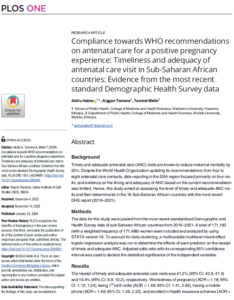
Background: Timely and adequate antenatal care (ANC) visits are known to reduce maternal mortality by 20%. Despite the World Health Organization updating its recommendations from four to eight antenatal care contacts, data reporting in the SSA region focused primarily on four visits, and evidence on the timing and adequacy of ANC based on the current recommendation was limited. Hence, this study aimed at assessing the level of timely and adequate ANC visits and their determinants in the 18 Sub-Saharan African countries with the most recent DHS report (2016-2021).
Methods: The data for this study were pooled from the most recent standardized Demographic and Health Survey data of sub-Saharan African countries from 2016-2021. A total of 171,183 (with a weighted frequency of 171,488) women were included and analyzed by using STATA version 16. To account for data clustering, a multivariable multilevel mixed-effect logistic regression analysis was run to determine the effects of each predictor on the receipt of timely and adequate ANC. Adjusted odds ratio with its corresponding 95% confidence interval was used to declare the statistical significance of the independent variables.
Results: The receipt of timely and adequate antenatal care visits was 41.2% (95% CI: 40.9, 41.4) and 10.4% (95% CI: 9.9, 10.2), respectively. Wontedness of pregnancy [AOR = 1.18; 95% CI: 1.13, 1.24], being 1st birth order [AOR = 1.48; 95% CI: 1.41, 2.54], having a mobile phone [AOR = 1.49; 95% CI: 1.26, 2.32], and enrolled in Health insurance schemes [AOR = 2.03; 95% CI: 1.95, 2.42] were significantly associated with early initiation of ANC. Living in a lower community poverty level[AOR = 2.23; 95% CI: 1.90,2.66], being in the richest wealth quintile [AOR = 1.49; 95% CI: 1.36, 1.62], higher educational level [AOR = 3.63; 95% CI: 3.33, 3.96], the timing of ANC visit [AOR = 4.26; 95% CI: 4.08, 4.44], being autonomous in decision making [AOR = 2.29; 95% CI: 1.83, 2.54] and having a mobile phone [AOR = 1.89; 95% CI: 1.76, 2.52] were identified as significant predictors of adequate ANC uptake.
Conclusion: The findings revealed a low coverage of timely and adequate ANC visits in SSA countries. Governments and healthcare managers in sub-Saharan African countries should leverage their efforts to prioritize and implement activities and interventions that increase women’s autonomy, and economic capability, to improve their health-seeking behavior during pregnancy. More commitment is needed from governments to increase mobile phone distribution across countries, and then work on integrating mHealth into their health system. Finally, efforts should be made to increase the coverage of health insurance schemes enrolment for the citizens.